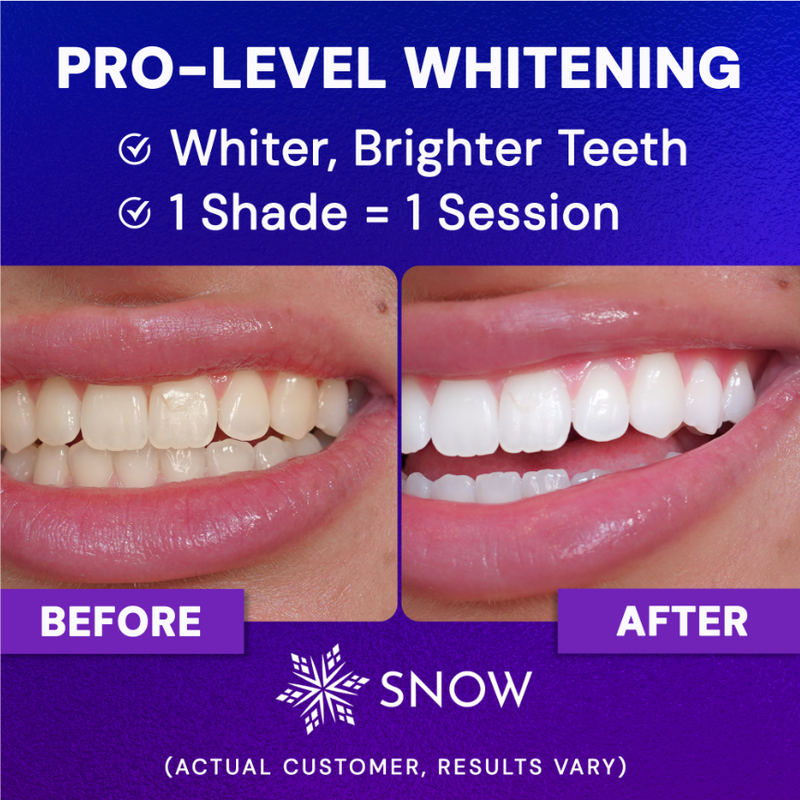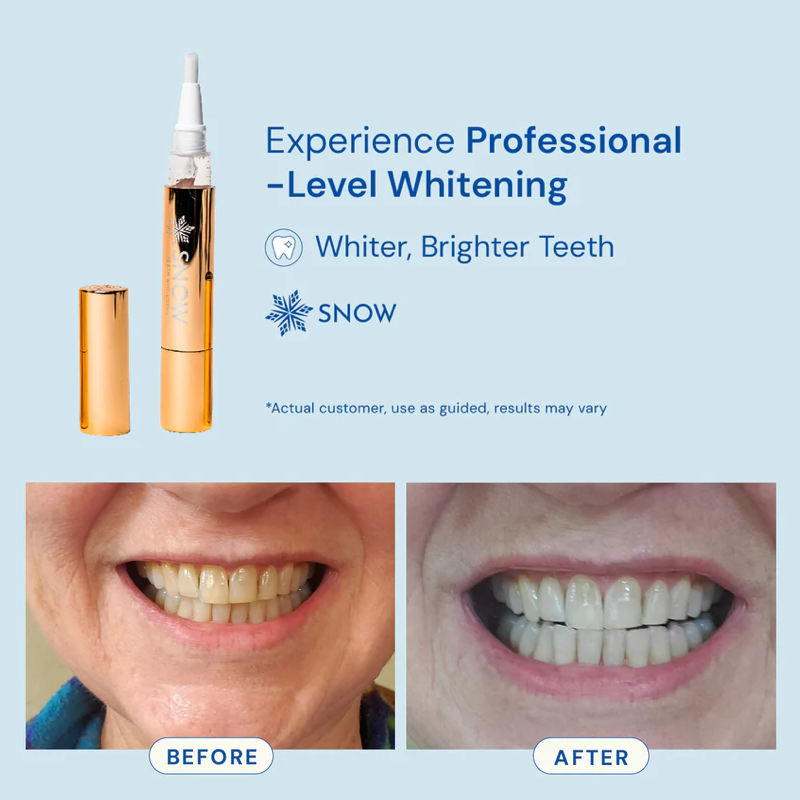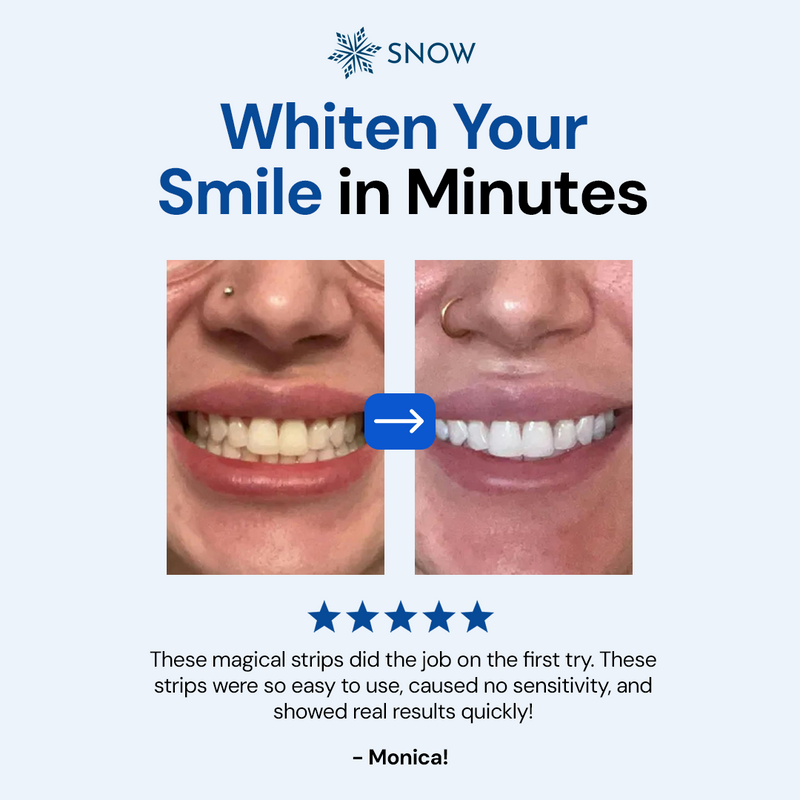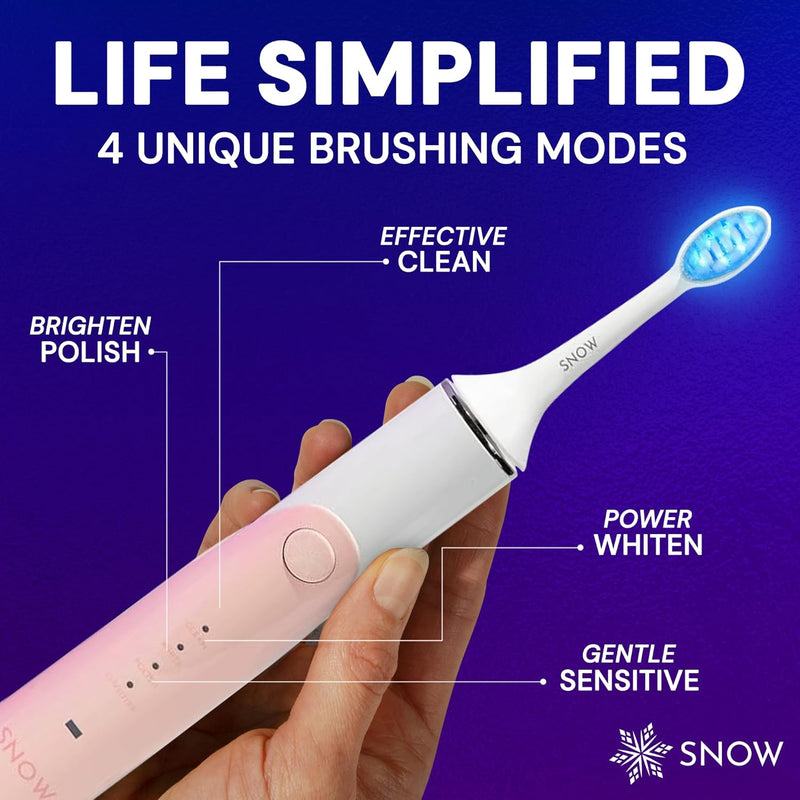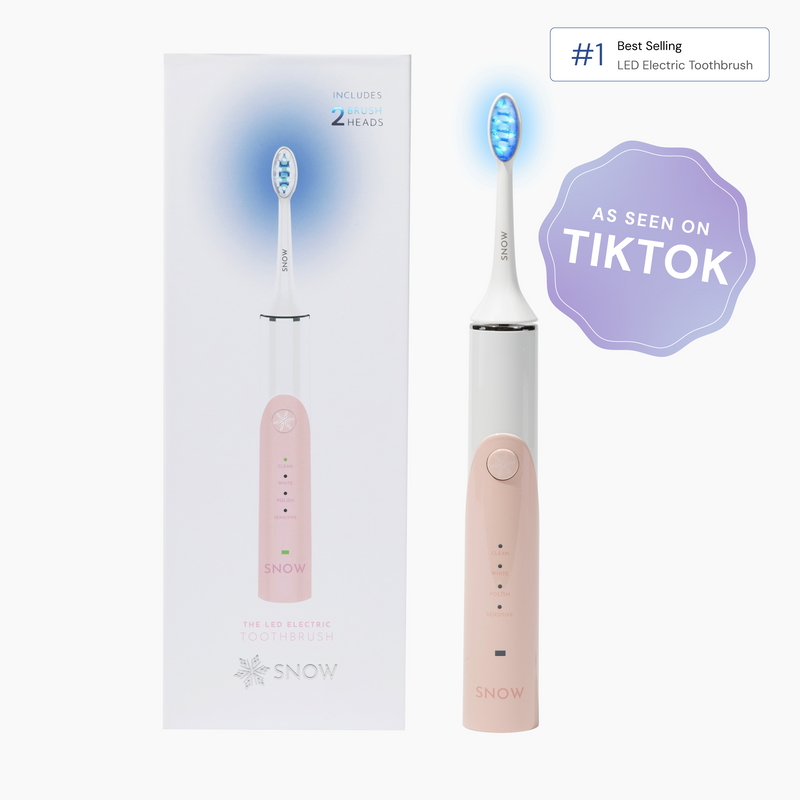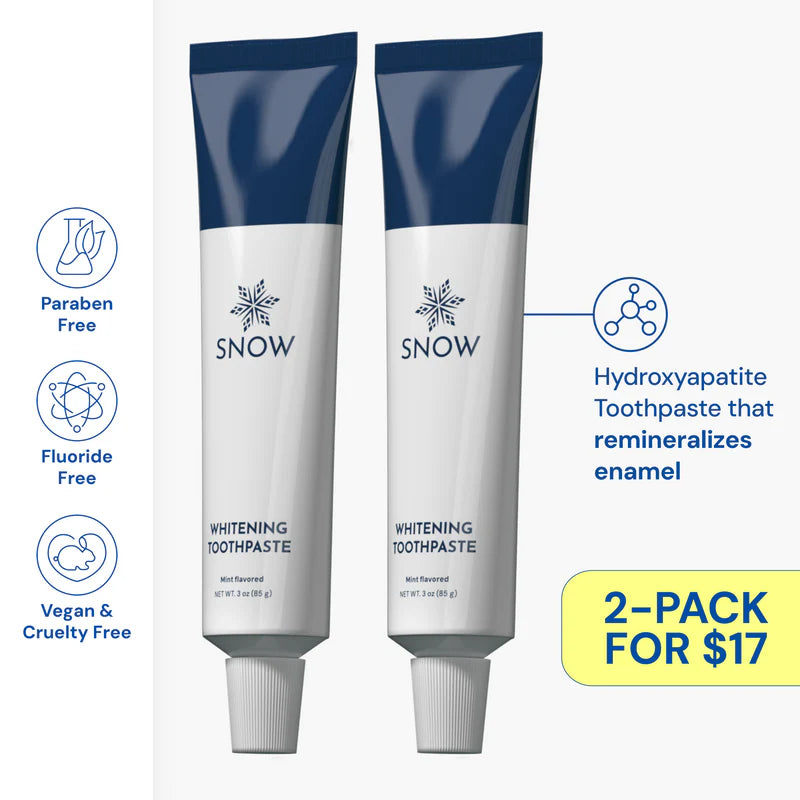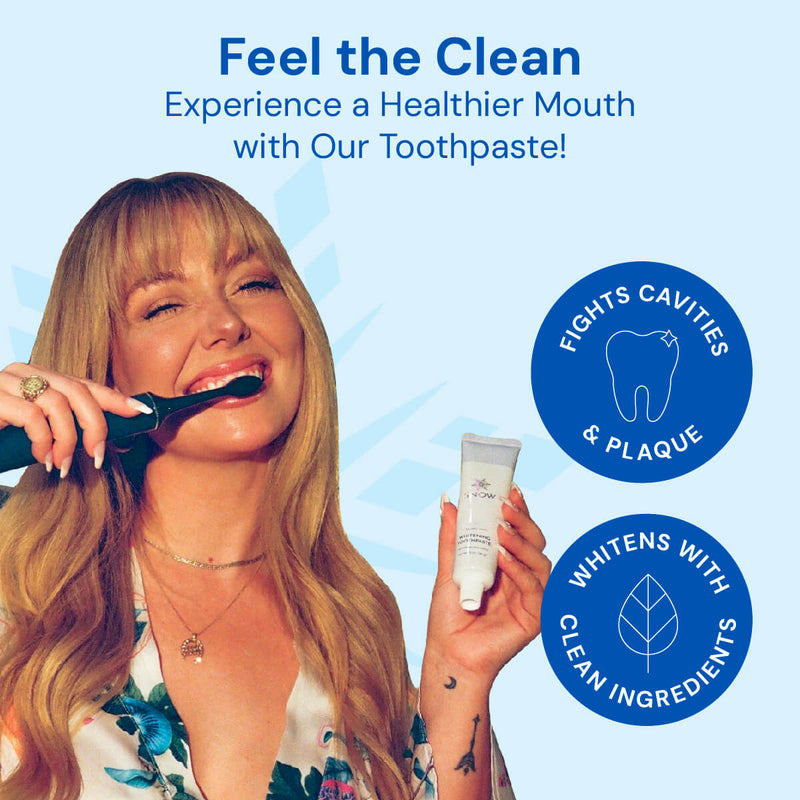Why did my teeth turn yellow all of a sudden? This question often arises when you notice a sudden change in your dental aesthetics. The primary reasons for this unexpected yellowing include dietary habits, tobacco use, poor dental hygiene, aging, and certain medications.
In this comprehensive guide, we'll explore the various causes of tooth discoloration, delve into why teeth can suddenly turn yellow, and provide practical tips on maintaining and preventing yellow teeth.
Our focus will be on effective at-home teeth whitening solutions, ensuring you have all the information needed to restore and maintain a bright, confident smile.
What this article covers:- What Is Tooth Discoloration?
- Reasons Your Teeth Might Suddenly Turn Yellow Near the Gums
- How to Maintain Whitened Teeth
- How to Prevent Tooth Discoloration
What Is Tooth Discoloration?
Tooth discoloration is a common dental concern that many of us encounter. It's not just about yellowing; discoloration can manifest in various hues and intensities, ranging from yellow tints to brown spots and even shades of gray.
Understanding that teeth naturally vary in shade is crucial, but it's the external factors that often lead to noticeable changes in color.
At SNOW, we believe in educating our customers about these changes, as it's the first step towards effective treatment and prevention.

Extrinsic Vs. Intrinsic Discoloration
According to WebMD, tooth discoloration can be categorized as extrinsic or intrinsic. Extrinsic discoloration occurs when external factors affect the outer layer of the tooth.
Common culprits include foods and drinks like coffee, tea, colas, wines, and certain fruits and vegetables, as well as tobacco use. Poor dental hygiene, which leads to plaque buildup, can also contribute to this type of staining.
Intrinsic discoloration, on the other hand, is due to factors affecting the tooth from within. This can be caused by diseases that affect enamel and dentin, certain medications like tetracycline and doxycycline, dental materials, and even genetics.
Aging also plays a role, as the enamel wears down over time, revealing the naturally yellow dentin.
Age-Related Discoloration
Age-related discoloration is a combination of extrinsic and intrinsic factors. As we age, the enamel on our teeth naturally wears down, making the yellow dentin more visible.
This process is often exacerbated by a lifetime of consuming stain-causing foods and beverages, as well as tobacco use.

Environmental Factors
Environmental factors, such as excessive fluoride from certain water sources or dental products, can also lead to tooth discoloration. This is often seen as white spots on the teeth, a condition known as fluorosis.
Trauma And Disease
Trauma to the teeth, especially in young children whose teeth are still developing, can disrupt enamel formation and lead to discoloration.
Diseases that affect the enamel and dentin, as well as treatments like chemotherapy and radiation, can also cause changes in tooth color.
Reasons Your Teeth Might Suddenly Turn Yellow Near the Gums
Sudden yellowing of teeth can be alarming and often leaves many wondering about the underlying causes. At SNOW, we understand the importance of addressing these concerns promptly and effectively.
Sudden yellow discoloration of teeth can be attributed to a few specific factors, distinct from the general causes of tooth discoloration.
A Change In Diet Or Habits
A sudden increase in the consumption of stain-causing foods and drinks can quickly affect the color of your teeth. Foods and beverages like coffee, tea, red wine, and certain fruits are known for their staining properties.
If you've recently changed your diet to include more of these items, this could be the reason behind the sudden yellowing.
Dental Trauma
Dental trauma is another factor that can lead to sudden discoloration. An injury to the mouth can damage the internal structure of the teeth, leading to a change in color.
This is often seen as a darker or yellowish hue, indicating that the tooth has been affected beyond just the surface level.

Illness
Certain medical conditions and treatments can also cause your teeth to suddenly turn yellow. For instance, chemotherapy and radiation treatments are known to affect the color of your teeth.
Additionally, some illnesses can lead to dehydration or changes in saliva production, which in turn can impact oral health and tooth color.
At SNOW, we're committed to providing solutions that not only whiten your teeth but also cater to the overall health of your mouth. Understanding the reasons behind sudden yellowing is crucial in choosing the right teeth-whitening approach.
How to Maintain Whitened Teeth
Maintaining whitened teeth is essential for lasting results and a confident smile. At SNOW, we understand the importance of a comprehensive approach to oral hygiene and offer a range of products specifically designed to help you keep your teeth bright and healthy.
Regular Dental Hygiene
The foundation of maintaining whitened teeth is regular dental hygiene. Brushing twice a day and flossing daily are crucial habits. To enhance your routine, consider using our LED Teeth Whitening Electric Toothbrush. This innovative toothbrush not only cleans your teeth effectively but also uses LED light to aid in maintaining your whitening results.
Dietary Choices
Limiting foods and drinks that stain teeth is another key aspect. Coffee, tea, red wine, and certain fruits can cause staining. When you do indulge, brushing or rinsing soon after can help minimize the effects.
Regular Dental Checkups
Professional cleanings are important for removing surface stains and maintaining oral health. Between visits, our Magic Teeth Whitening Strips can be a convenient way to touch up your smile at home.
At-Home Whitening Kits
For ongoing maintenance, SNOW offers a range of at-home whitening kits. Our Original Teeth Whitening Kit is a popular choice, providing professional-level whitening with minimal sensitivity. For a more advanced option, our Wireless Teeth Whitening System offers a hands-free, effortless whitening experience.
Whitening Water Flosser
In addition to brushing and whitening, flossing is vital for maintaining oral health and preventing stains. Our Whitening Water Flosser not only helps clean between your teeth but also aids in whitening, offering a dual benefit.
By incorporating these products and habits into your routine, you can enjoy long-lasting whitening results and a brighter, more confident smile. At SNOW, we're committed to providing innovative solutions for all your teeth whitening needs.

How to Prevent Tooth Discoloration
Preventing tooth discoloration is crucial for maintaining a bright and healthy smile. At SNOW, we believe in a proactive approach to oral care. Here's a step-by-step guide to help you keep your teeth looking their best.
Quit Smoking
- Identify Triggers: Recognize situations that make you want to smoke.
- Seek Alternatives: Use nicotine patches or gum to ease cravings.
- Get Support: Join a quit-smoking program or support group.
Tobacco is a major culprit in tooth discoloration. Quitting smoking not only improves your oral health but also benefits your overall well-being.
Use Straws
- Choose the Right Straw: Opt for a reusable straw to minimize environmental impact.
- Incorporate into Routine: Make it a habit to use a straw for stain-causing drinks like coffee, tea, and sodas.
- Clean Regularly: Keep your reusable straws clean to maintain oral hygiene.
Using a straw minimizes the contact of stain-causing liquids with your teeth, thereby reducing the risk of discoloration.
Dental Hygiene Products
- Select Whitening Toothpaste: Choose a toothpaste with whitening properties.
- Incorporate Mouthwash: Use a whitening mouthwash as part of your daily routine.
- Regular Brushing and Flossing: Brush at least twice a day and floss daily to remove plaque and prevent staining.
Using the right dental hygiene products is essential in preventing tooth discoloration. According to the Cleveland Clinic, maintaining good oral hygiene is key to preventing stains and keeping your teeth healthy.
By following these steps and incorporating quality products like those offered by SNOW, you can effectively prevent tooth discoloration and enjoy a brighter smile. Remember, consistent care is the key to lasting results.
Conclusion
Understanding why teeth turn yellow and how to address it is crucial for maintaining a confident smile. From identifying the causes of tooth discoloration to exploring effective prevention and maintenance strategies, we've covered essential aspects of oral health.
Remember, regular dental hygiene, smart dietary choices, and the right teeth whitening products are key to combating yellow teeth.
For those looking to enhance their smile, explore our range of teeth whitening solutions at SNOW.
If you enjoyed this article, check out some of our related posts:
- Why Do My Teeth Never Get White
- Why Are My Canine Teeth Yellow
- Why Are My Teeth Not Whitening
- Why Do My Teeth Look More Yellow After Whitening Strips
- Why Are Teeth White
- Why Are My Top Teeth Whiter Than My Bottom Teeth
- Black Stains on Teeth
- Tooth Stain vs Cavity
- How to Fix Stained Teeth
- Hard Water Stains on Teeth
- Stained Teeth Causes
- Does Porcelain Teeth Stain?
- Which Liquid Stains Your Teeth the Most?
- Why Do British Have Yellow Teeth?
- Why Do Americans Have Such White Teeth?















































